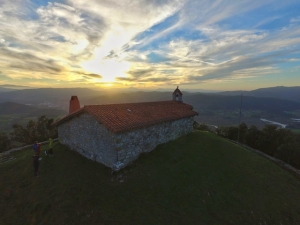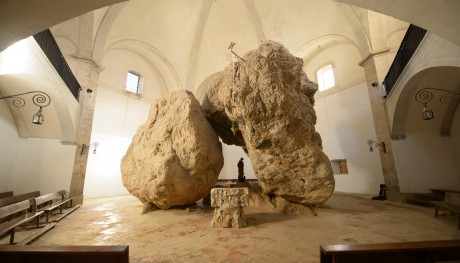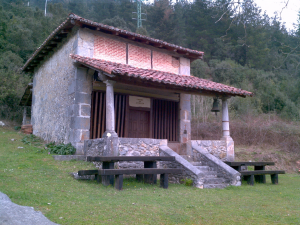Beliefs and rituals surrounding the chapels of el Duranguesado, Lekeitio and Xemein
- Gurutzi Arregi. Department of Ethnographics at the Labayru Institute
- 15/ 10/ 2001
Over 800 chapels have been counted over the centuries, with the figures currently standing at 496 (2), in the historical territory of Biscay. These small buildings presided by the Holy Cross or a Saint have been sacred places where people have gone to pray for the prevention or cure of certain illnesses. Groups of people or individuals have also gone there to ask for other things needed in their lives. In certain cases, they do not go to the chapel or sanctuary itself, but rather to the source or rock linked to the sanctuary or chapel and they attribute curing properties to the waters of the source or contact with the rock.

At the same time that they asked the saint for grace, they offered up something that belonged to them: oil, wheat, candles, livestock or money. The religiosity that is detected through these practices has a markedly utilitarian nature and normally falls within parameters when the contractual relation prevails: "I offer you something so that you give me something" and "I thank you so that you continue protecting me".
In order to perform the rituals to ask for protection, they used elements or objects that belong to the sacred place: blessed water, oil from the lamp, bells, images with their attributes, the alter, certain hollows in the fall, etc.
The data that we have set out here were collected from the field work that we carried out during the Seventies (1972-1982) and refer to the rituals performed for cures and protection (of people) in chapels located in the Merindad de Durango, in Markina-Xemein and in Lekeitio.
Matrimony - Fertility - Pregnancy
San Antonio de Padua, whose sanctuary is located in the port of Urkiola, was traditionally invoked by young women in order to find a husband. Even up to fairly recent times, spinsters used a pin with a black head, if they preferred a husband who was dark, or a white head, if they wanted a blond. There was a small cork panel where they stuck these pins in the ex-voto chapel that disappeared as a result of the 1973 renovation and letters asked San Antonio for a husband were placed in the "Petitions and Alms" box inside the church. Opposite the sanctuary, in the middle of the countryside, there was a large, round stone and the girls used to go round three times in order to find a husband.
In the Sanctuary of San Miguel de Arretxinaga, located in Markina-Xemein, single women still go through the narrow gap, that is under the huge rocky outcrops to be found inside it, three times. They have to say three Hail Marys as they slide through. Single men also perform this ritual, although this happens less frequently.

There are sanctuaries in Bizkaia where people go to ask for children. One of the most notable one is the Chapel of San Jacinto in Markina-Xemein, which sterile women used to visit.
In the Chapel of Santo Cristo, popularly known as Kristo Andako, situated in the Mediola district of Abadiano, the women about to give birth invoked an image of the Virgin worshipped inside to ask for an easy labour. They also used to go the Chapel of Our Lady of Gatzagieta, that was located at the point where the old Abadiano and Mañaria roads met, one kilometre from the Sanctuary of Urkiola. The image that was worshiped in this chapel, that has today disappeared, was likely to have been taken to the Chapel of Santo Cristo de Atxarte and where pregnant women continue to flock to ask for a happy delivery. This was the reason behind the women visiting the Chapel of Our Lady of the Remedies in Otxandiano and the Chapel of Santa María de Mallabia.
First stage of life
Mothers who had problems with breast-feeding usually resorted to Chapels devoted to Santa Águeda in order to ask for their breasts to be cured. One of these chapels in the Lejarza district in Izurza.
Mother used to offer up their children to San Antonio de Padua in the Sanctuary of Urkiola and they generally did so before the child celebrated his first birthday. They used to go to the Sanctuary the night before and spent the night inside the building. The following day, after going to Mass, they asked for a special blessing for the child. This blessing was performed by means of reading of the first verses of the Gospel according to St. John. After this ritual was carried out, the parents made an offering of oil or wheat. The child was weighed on a scale known as the peso leal (loyal weight) and offered the same amount of wheat as the child's weight on that scale. Nowadays, only the ceremony of the blessing of the children is still held and it usually takes place during July.
The mother asked for the intervention of San Jacinto, whose chapel is in Xemein, in order for their children to grow normally or to be cured of a paralysis.
Curses - Evil eye - Possession
Children's excessive or furious crying was attributed to curses or to their having being given the evil eye. Equally, when a child was sickly, they believe that this was the result of their having been given the evil eye (begizko) by someone who wished their evil. In order to prevent this, the kutun used to be placed in the pleats of the bandage wrapped down the stomachs of the new-borns or hung from around their necks. This charm was an embroidered cloth bag that contained a piece of paper with the first words of the Gospel according to St. John, in the majority of cases. These little bags or kutunes were often provided by the nuns in the convents or purchased at the Sanctuary of Larrea, Amorebieta, where there used to be a chapel dedicated to San Juan.
In the Markina-Xemein area, new-born children who were always crying were taken to the Chapel of Our Lady of Erdotza, situated by the old road that led to the Collegiate Church of Zenarruza. In Elorrio, they were taken to the Chapel of San Urban, popularly known as Santruan.
People possessed were considered to be suffering from a far greater evil than that of begizko or evil eye. Yet, the rituals used to free them from both evils were said and confused. There were specific sanctuaries to cure this suffering. These included the Sanctuary of the Santos Antonios de Urkiola. Only the Dean of the Sanctuary used to hold the power to bless and "exorcise the people possessed by spirits and evil beings that came to the sanctuary". He used a Benedictionale, which contained certain rituals and ceremonies that were not included in the ordinary ritual. An old copy of this book is kept in the Sanctuary's Museum, next to a crucifix that was used for these exorcisms.
Headache
This illness is one of the most common reasons for people to resort to the chapels and sanctuaries throughout the country. This was the reason for going to the Chapel of San Martín de Murua in Markina, to give just one example.
Problems with sight
People asking for illnesses relating to their sight have traditionally turned to Santa Lucía, known popularly as Santa Lutzi. In the Merindad de Durango, they went to the chapel dedicated to this saint that is in the Iguria district of Elorrio.
Earache
The oil from the votive lamp in the chapel, in particular those dedicated to San Cristóbal, has been used as a cure for earache. A vessel full of oil was first of all offered beforehand in order to obtain a little of this liquid.
The chapel of San Cristóbal situated in the Mendiola district of Abadiano and that of Santa Engracia, Santa Engrazi, located in the Barinaga Brotherhood of Markina were places that people visited to be cured.
Toothache
Santa Apolonia, known popularly as Santa Polonia, is the patron saint of dentists. People go to the chapels dedicated to this saint to ask for their toothache to be cured.
This was the reason why people went to the Chapel of Santa Apolonia located in the district of the same name in Iurreta. The following ritual was carried out in the chapel situated near to the Sanctuary of Urikola: the people filled their mouths with the water from the source behind the chapel and then went round the building three times, before spitting out the water once they were inside. They said the Creed before and after performing this ritual and some people said three Hail Marys.
There are large limestone outcrops leaning against each other and on the floor inside San Miguel de Arretxinaga, in Xemein. There used to be two altars, one to San Miguel and another to Santa Apolonia, in the hollows between these rocks. People used to break off small pieces of the outcrop that was closest to the alter dedicated tot he Saint, in the belief that if these small bits of rock were placed in their mouths, they would cure their toothache. Nowadays, the image of Santa Apolonia is in the choir and away from being worshiped.
Sore throats
San Blas is the great protector from illnesses of the throat. On his saint's day, the 3rd of February, the cords of San Blas, San Blas arie or San Blas firue are blessed in numerous chapels and sanctuaries, as well as marshmallow sweets, fruits and doughnuts. It is mainly the women who take the food and cords to the church and then hang them round the neck of the children and old people. These cords are worn for nine consecutive days to protect the throats. At the end of this time, they are burnt in the stoves in the home, after having made the sign of the Cross or said the Hail Mary.
There are no chapels dedicated to San Blas in the municipal districts under study. In Lekeitio, they went to the chapel of Santa María Magdalena de Azurtua, where a Mass was said and the chords, sweets, chocolates and fruit blessed. On the day of the feast, the people from the villages of the Merindad de Durango go to the Parish Church of San Torcuato in Abadiano, where they worship an image of San Blas. The ritual to bless the cords and food is held there. An important livestock fair is held on the same day in this municipal district.
Close to the Chapel of San Juan Bautista, situated in the Murgoitio Brotherhood of Berriz, there is a spring to which curative properties have been attributed since time immemorial. Many people used to come here to drink and collect water from this source which, according to popular beliefs, cured illnesses of the throat and the tumours of the neck called iruntzpekoak.
Rheumatism
Rheumatism was another chronic illness that caused people to seek relief by turning to the chapels and sanctuaries. In Bizkaia, the people went to those dedicated to Santa Eufemia. The people suffering from pains around the waist, garriko miñe, went up to Santa Eufemia de Murelaga, which is located on the top of Monte Urregarai. This place was visited by many people from the towns situated in the Merindad de Durango and Markina. The person suffering from rheumatism used to climb up to the chapel after he had binding rolls of wax, metzarra, around this waist. The wax was list as he went into the chapel and left their as an offering. Nowadays, they offer candles. People suffering from this illness also went to the Chapel of Santa Eufemia located in the Arabio district of Elorrio.
Skin diseases
There are many types of skin diseases that appear in the realm of popular medicin. In the Chapel of Santo Domingo, also known as Santa Rosa, situated in the Plazakola district of Xemein, the people invoked the image of Santa Rosa. This image disappeared when there was a fire in the chapel. It was normal to first of all offer oil up to the Saint in order to then take burnt oil from the votive lamp and this oil was then rubbed on the types of skin injuries known as errosa.
Children were taken to Our Lady of Erdotza de Markina to cure burns to the groin.
San Lorenzo was also invoked to cure boils, general rashes and burns. People went to the dedicated to this saint in the Leaniz district of Elorio to ask for boils to be cured.
Mental illnesses
People asking for mental illnesses to be cured went to the chapel of Santa Catalina located in the Iguria district of Elorrio.
Rabies
People who have been bitten by a dog pray to the image of San Bernardo that was worshipped in the old Cistercian monastery of Barria (Álava), that is nowadays disaffected. People even went there from Bizkaia. This entry is to be found in the 1783 accounts for the parish of Izurza, Merindad de Durango:
"It. Fifteen reales that are given by order of the town council and neighbours of this parish to the wife of Icabalceta, neighbour of this parish, for the journey that she made to the Monastery to be blessed to be cured of rabies".
Plagues
According to the various local traditions, the chapel that are dedicated to San Roque were built as a result of these collective disasters. The Chapel of San Roque in the Urkizuaran district of Elorrio, the one in Otxandiano next to the cemetery and the chapel of Santa Elena y San Roque in Lekeitio were built for this reason. During the novenary, the Gozos (poem in honour of the Virgin) were recited in the chapel dedicated to the saint in Durango and she was asked to protect the people against plagues and evils. The refrain went as following:
Pues médico eres divino
Con prodigiosas señales,
Líbranos de pestes y males
Roque Santo peregrino.
(As a doctor you are divine
With prodigious proof,
Free us from plagues and evils,
Roque, pilgrim saint)
Praying for health
People went to the Chapel of San Cosme y San Damián in Xemein to pray for good health. These martyr saints were doctors according to tradition.
There is still a cosmogonic aspect that revolves around the solstices and equinoxes in the traditional calendar, above all in rural area. During this period of the year, the symbolic activity intensifies, such as the ones that appear in the rituals linked to the natural cycles and agricultural activities. Livestock that is considered as a fundamental asset within the rural economy are protected by the saints. There is a reason for each festivity and a saint for each necessity (3).
(1) Instituto Labayru. Larrrauri, 1 A-5º - 48160 Derio (Bizkaia) e-mail: idazkaritza@labayru.org
(2) Gurutzi ARREGI AZPEITIA. Ermitas de Bizkaia. Bilbao, Labayru Institute-Provincial Council of Bizkaia, 1987, 3 volumes.
(3) Gurutzi ARREGI. Origen y significación de las ermitas de Bizkaia. Bilbao, Instituto Labayru-Bilbao Bizkaia Kutxa, 1999.








